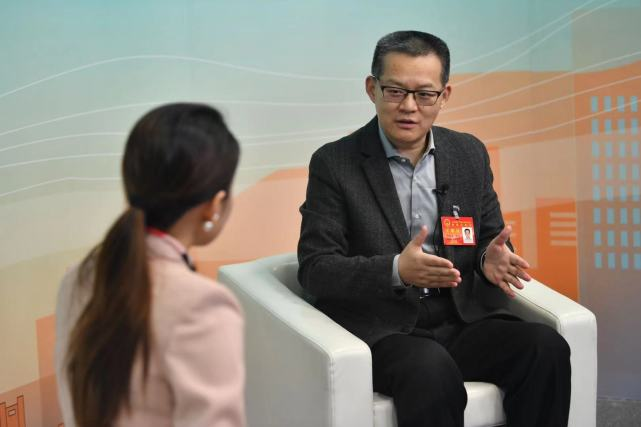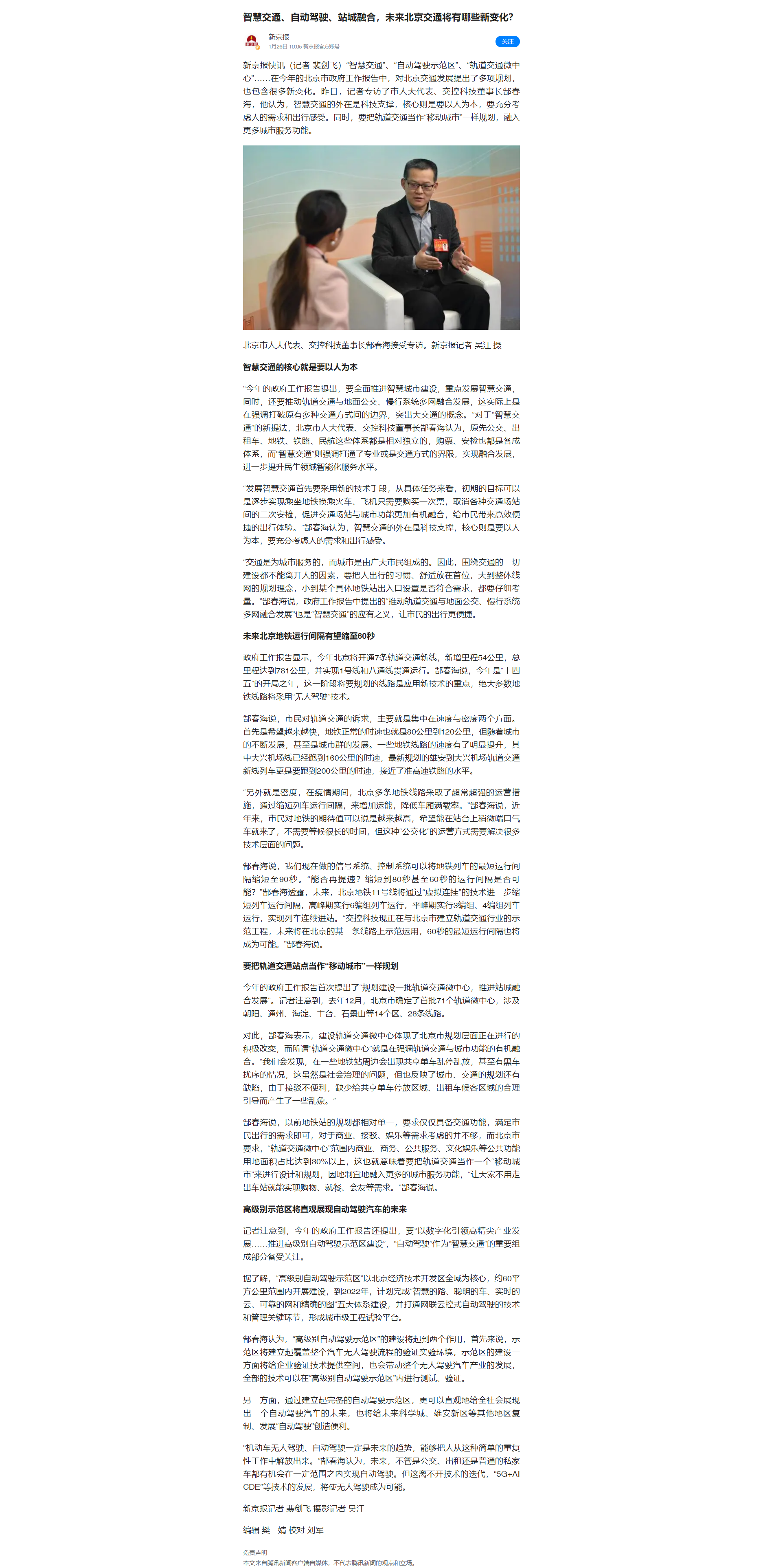Beijing News Express (Reporter Pei Jianfei) "Intelligent Transportation", "Autopilot Demonstration Zone", "Rail Transit Micro Center" …... In this year's Beijing government work report, a number of plans for Beijing's transportation development are put forward, including many new changes. Yesterday, the reporter had an exclusive interview with Gao Chunhai, deputy to the Municipal People's Congress and chairman of Traffic Control Technology. He believed that the external aspect of intelligent transportation is the support of science and technology, while the core is to be people-oriented and take full account of people's needs and travel feelings. At the same time, rail transit should be planned as a "mobile city" and be integrated into more urban service functions.

Gao Chunhai, deputy to the Beijing Municipal People's Congress and chairman of Traffic Control Technology, accepted an exclusive interview. Photo taken by Wu Jiang, a reporter from the Beijing News.
The core of intelligent transportation is to be people-oriented.
"This year's government work report proposes to comprehensively promote the construction of smart cities, focus on the development of intelligent transportation, and also promote the development of multi-network integration of rail transit, ground public transportation and slow-going systems. In fact, this is to emphasize breaking the boundary between the original various modes of transportation and highlighting the concept of big traffic." With regard to the new formulation of "intelligent transportation," Lu Chunhai, deputy to the Beijing Municipal People's Congress and chairman of Traffic Control Technology, believes that the original bus, taxi, subway, railway, and civil aviation systems are all relatively independent, and ticket purchase and security checks are also separate systems, while "intelligent transportation" emphasizes opening up the boundaries of specialties or modes of transportation, realizing integrated development, and further improving the level of intelligent services in the field of people's livelihood.
"To develop intelligent transportation, we must first adopt new technical means. From the perspective of specific tasks, the initial goal can be to gradually realize that we only need to buy a ticket to change trains and planes by subway, cancel the second security check between various traffic stations and stations, promote more organic integration of traffic stations and urban functions, and bring efficient and convenient travel experience to citizens." Gao Chunhai believes that the external support of intelligent transportation is from science and technology, while the core is to be people-oriented, taking full account of people's needs and travel feelings.
"Traffic serves the city, and the city is made up of the general public. Therefore, all construction around traffic cannot be separated from human factors, and people's travel habits and comfort should be put in the first place, including factors from the planning concept of the overall line network to whether the entrance and exit settings of a specific subway station meet the needs. " Gao Chunhai said that "promoting the integrated development of rail transit, ground public transportation and slow transit system" proposed in the government work report is also the due meaning of "smart transportation" to make it more convenient for citizens to travel.
In the future, the running interval of Beijing subway is expected to be reduced to 60 seconds.
According to the government work report, seven new rail transit lines will be opened in Beijing this year with an additional mileage of 54 km, which brings the total mileage to 781 km, and the operation of Line 1 and Batong Line will be completed. Gao Chunhai said that this year is the beginning of the 14th Five-Year Plan, the lines to be planned on this stage will be the focus of the application of new technologies, and the vast majority of subway lines will adopt "self-driving" technology.
Gao Chunhai said that the citizens' demand for rail transit is mainly focused on speed and density. First of all, we hope to get faster and faster, the normal speed of the subway is 80 kilometers to 120 kilometers per hour, but with the continuous development of the city, even the development of urban agglomeration. The speed of some subway lines has been significantly improved, of which the Daxing Airport Line has reached a speed of 160 kilometers per hour, and the newly planned train from Xiongan to Daxing Airport Rail Transit Line will reach a speed of 200 kilometers per hour, close to the level of quasi-high-speed railway.
"An additional factor is the density. During the epidemic, many subway lines in Beijing adopted extraordinary and super-strong operation measures to increase transport capacity and reduce the full load rate by shortening the interval between train operation." Gao Chunhai said that people's expectations of the subway can be said to be getting higher and higher in recent years. They hope that the train will come after a little catch of breath on the platform, and it will not take a long time to wait. However, this "public transportation" mode of operation needs to solve many technical problems.
Gao Chunhai said that the signal system and control system we are doing now can reduce the minimum running interval of subway trains to 90 seconds. "Can the speed be accelerated? Is it possible to shorten the running interval to 80 seconds or even 60 seconds? “Gao Chunhai revealed that Beijing Metro Line 11 will further shorten the train operation interval through the technology of "virtual connection" in the future, 6-car train will be operated during peak hours, and 3-car and 4-car train will be operated during peak periods to achieve continuous entry of trains. "Traffic Control Technology is now establishing a demonstration project with Beijing for the rail transit industry, which will be demonstrated on a certain line in Beijing in the future, and a minimum operating interval of 60 seconds will also be possible." Gao Chunhai said.
Rail transit stations should be planned as "mobile cities".
This year's government work report put forward for the first time "planning and construction of a number of rail transit microcenters to promote the integrated development of stations and cities". The reporter noted that Beijing identified the first batch of 71 track microcenters in December last year, which involved 14 districts and 28 lines such as Chaoyang, Tongzhou, Haidian, Fengtai and Shijingshan.
In this regard, Gao Chunhai said that the construction of rail transit microcenters reflected the positive changes that were taking place at the planning level in Beijing, and the so-called "rail transit microcenters" emphasized the organic integration of rail transit and urban functions. "We would find that shared bikes were parked and disordered around some subway stations, and even black cars would be out of order. Although this was a problem of social governance, it also reflected that there were still defects in the planning of cities and transportation. Due to the inconvenient connection, some chaos had been caused by the lack of reasonable guidance for shared bike parking areas and taxi waiting areas."
Gao Chunhai said that the planning of subway stations was relatively simple in the past, which required only transportation functions to meet the needs of citizens to travel, but not enough to consider the needs of commerce, connection, entertainment and so on. Beijing requires that the area of commercial, commercial, public services, cultural and entertainment and other public functions within the "rail transit microcenter" accounts for more than 30%. This means that rail transit should be designed and planned as a "mobile city", and more urban service functions should be integrated according to local conditions, "so that people can realize the needs of shopping, dining, friends and so on without going out of the station." Gao Chunhai said.
The high-level demonstration zone will directly show the future of self-driving cars.
The reporter noted that this year's government work report also proposed that it was necessary to "lead the development of sophisticated industries with digitalization."... and promote the construction of high-level autopilot demonstration zone"," and autopilot "as an important part of "intelligent transportation "had attracted much attention.
It is understood that the "High-level self-driving demonstration Zone" takes the whole area of the Beijing Economic and technological Development Zone as the core, and the construction is carried out within an area of about 60 square kilometers. By 2022, it is planned to complete the construction of the five major systems of "smart road, smart car, real-time cloud, reliable network and accurate map", and open up the key links of network-connected cloud-controlled self-driving technology and management to form a city-level engineering test platform.
Gao Chunhai believed that the construction of the "high-level self-driving demonstration zone" would play two roles. First of all, the demonstration zone will set up a verification experimental environment covering the entire self-driving process of cars. On the one hand, the construction of the demonstration zone will provide space for enterprises to verify technology, and it will also promote the development of the entire self-driving car industry. All technologies can be tested and verified in the "high-level self-driving demonstration zone."
On the other hand, by establishing a complete self-driving demonstration zone, we can directly show the future of self-driving cars to the whole society, and it will also facilitate the replication and development of "self-driving" in other areas such as the Science City and Xiongan New Area in the future.
"Self-driving and self-driving of motor vehicles must be the trend of the future, which can liberate people from this simple and repetitive task." Gao Chunhai believed that regardless of public transportation, taxi or ordinary private cars, there would be opportunities to achieve self-driving within a certain range in future. However, this is inseparable from the iteration of technology, and the development of technologies such as "5G+AICDE" will make self-driving possible.




